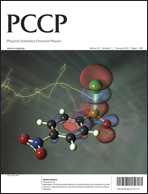Control of interlayer friction in two-dimensional ferromagnetic CrBr3
IF 2.9
3区 化学
Q3 CHEMISTRY, PHYSICAL
引用次数: 0
Abstract
Two-dimensional (2D) magnetic materials may offer new opportunities in the field of lubrication at nanoscale. It is essential to investigate the interfacial property, particularly magnetic coupling, at the interfaces of 2D magnetic materials from the point view of friction. In the present study, we investigated the tribological and interfacial properties at the interface of bilayer CrBr3 by performing the first-principles calculations. The effects of normal load, biaxial strain and carrier doping on the interlayer magnetic coupling were also studied. Our calculations identify the ferromagnetic (FM) - antiferromagnetic (AFM) conversion of the interlayer magnetic couplings, which leads to the reduction of the sliding energy barriers. Importantly, our calculations demonstrate the lower sliding energy barrier at the interface of 2D FM CrBr3, implying lower friction and better lubricating property. Additionally, we found that the normal load of 0.5 ~ 1.0 eV/Å, biaxial compressive strain of 0% ~ -5%, and carrier doping of -0.2 ~ 0.2 e f.u.-1 are effective on reducing the sliding energy barrier and the friction. It is also found that the biaxial strain tunes the interlayer electron redistribution, and thus alters the interlayer interaction and friction. The differences between the lubricating properties of 2D magnetic CrX3 (X = Cl, Br and I) have also been studied. The present findings are inspiring for the application of 2D magnetic materials as solid lubricant in the fields of lubrication at nanoscale.二维铁磁性 CrBr3 的层间摩擦控制
二维(2D)磁性材料可能为纳米级润滑领域提供新的机遇。从摩擦的角度研究二维磁性材料界面的界面特性,特别是磁耦合,是非常重要的。在本研究中,我们通过第一性原理计算研究了双层 CrBr3 界面的摩擦学特性和界面特性。我们还研究了法向载荷、双轴应变和载流子掺杂对层间磁耦合的影响。我们的计算确定了层间磁耦合的铁磁(FM)-反铁磁(AFM)转换,从而降低了滑动能垒。重要的是,我们的计算表明二维 FM CrBr3 界面的滑动能垒更低,这意味着摩擦力更低,润滑性能更好。此外,我们还发现 0.5 ~ 1.0 eV/Å的法向载荷、0% ~ -5%的双轴压缩应变和 -0.2 ~ 0.2 e f.u.-1的载流子掺杂能有效降低滑动能垒和摩擦力。研究还发现,双轴应变会调整层间电子的重新分布,从而改变层间相互作用和摩擦力。此外,还研究了二维磁性 CrX3(X = Cl、Br 和 I)润滑特性之间的差异。本研究结果对二维磁性材料作为固体润滑剂在纳米级润滑领域的应用具有启发意义。
本文章由计算机程序翻译,如有差异,请以英文原文为准。
求助全文
约1分钟内获得全文
求助全文
来源期刊

Physical Chemistry Chemical Physics
化学-物理:原子、分子和化学物理
CiteScore
5.50
自引率
9.10%
发文量
2675
审稿时长
2.0 months
期刊介绍:
Physical Chemistry Chemical Physics (PCCP) is an international journal co-owned by 19 physical chemistry and physics societies from around the world. This journal publishes original, cutting-edge research in physical chemistry, chemical physics and biophysical chemistry. To be suitable for publication in PCCP, articles must include significant innovation and/or insight into physical chemistry; this is the most important criterion that reviewers and Editors will judge against when evaluating submissions.
The journal has a broad scope and welcomes contributions spanning experiment, theory, computation and data science. Topical coverage includes spectroscopy, dynamics, kinetics, statistical mechanics, thermodynamics, electrochemistry, catalysis, surface science, quantum mechanics, quantum computing and machine learning. Interdisciplinary research areas such as polymers and soft matter, materials, nanoscience, energy, surfaces/interfaces, and biophysical chemistry are welcomed if they demonstrate significant innovation and/or insight into physical chemistry. Joined experimental/theoretical studies are particularly appreciated when complementary and based on up-to-date approaches.
 求助内容:
求助内容: 应助结果提醒方式:
应助结果提醒方式:


